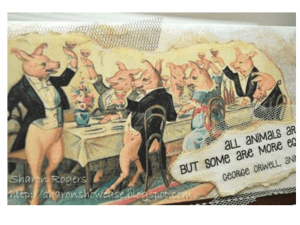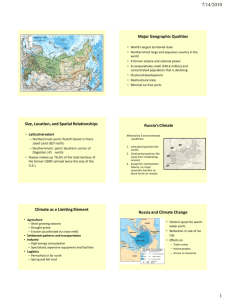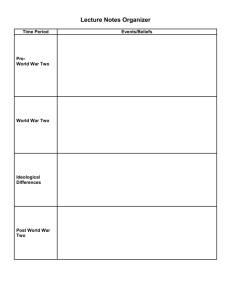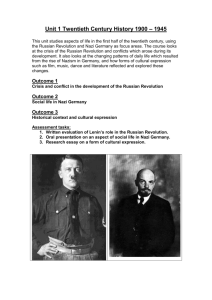Some text - Syracuse University
advertisement
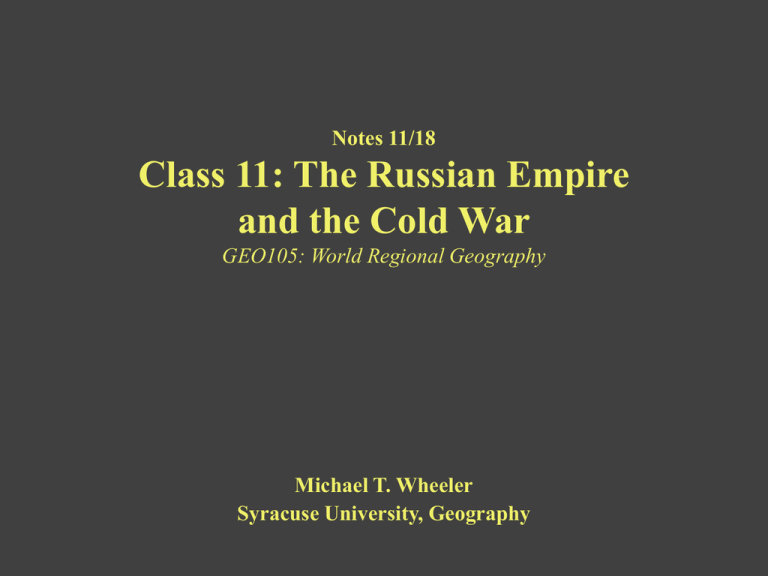
Notes 11/18 Class 11: The Russian Empire and the Cold War GEO105: World Regional Geography Michael T. Wheeler Syracuse University, Geography Lecture slide 02 Global Tectonics 2.5 Major tectonic plates (p. 39) 2 Lecture slide 03 Physiographic Regions 4.3 Physiographic regions of the [former Soviet Union] (pp. 136-7) 3 Lecture slide 04 13th Century, Mongol Invasion 4 Lecture slide 05 Mongols in Europe 5 Lecture slide 06 Mongol States • Conquered Empires – – – – China Persia Korea Threatened Japan (‘Kamikazes’ – divine wind) 6 Lecture slide 07 Russian Revival • Under Mongols – Moscow occupied – Novgorod survived • 15th-16th Centuries – Regional power: Poland / Lithuania – Iberians discovering the New World – Local kingdom of Muscovy begins expansion of Slavic state 7 Lecture slide 08 The Russian Empire 15th-20th Centuries 4.16 Territorial growth of the Muscovite/Russian state (p. 146) 8 Lecture slide 09 The Russian Empire, until 1795 • Settlement – Almost all along the southern edge – Fortified towns (like Fort Apache) 9 Lecture slide 10 Western Development until 1795 • Minerals • Brutal regime • Peasant uprisings • No Finland • (or Poland) 10 Lecture slide 11 Napoleon Invades, 1812 • 1861 Minard Map – Six variables: location (2), direction (1), time (1), army size (1), temperature (1) • Tufte, The Visual Display of Quantitative Information, 1983 11 Lecture slide 12 Expansion until 1914 • Geography – Central Asia – Caucus – Alaska • Economy – Minerals in the shield – Pacific coast – Trans-Siberian Railroad 12 Lecture slide 13 Emigration to ‘Asiatic Russia’ • Attempted Modernization – Count Witte – Forcibly export grain • December Revolution, 1905 13 Lecture slide 14 World War I 14 Lecture slide 15 The Russian Revolution, 1917-1921 • Bolsheviks – Dedicated to world-wide revolution – Export Communism • Other developed countries – Intervene to put down Communists – Canada, France, Greece, Great Britain, United States, Japan • Civil War – Reds vs. Whites • Geography – Other Europeans lopped off big parts of former Russian Empire 15 Lecture slide 16 World-Wide Revolution • Socialist Parties – Almost all supported World War One • Major countries – France – Germany • Rosa Luxemborg – China • Mao Tse Tung • Chou En Lai – United States • Eugene Debs 16 Lecture slide 17 Break 4.20 Population density (p. 153) 17 Lecture slide 18 World War II 18 Lecture slide 19 Nazi-Soviet Pact Population Movements 19 Lecture slide 20 Post War Population Movements 20 Lecture slide 21 The Holocaust 21 Lecture slide 22 Unimaginable Destruction • People – 7.5 million soldiers – 6-8 million civilians, directly – “indirect losses” – Total: 20-25 m people! • Agriculture – – – – 7m out of (11.6m) horses 20m (out of 23m) pigs 137,000 tractors 49,000 grain combines • Transportation – 65,000 km of railroads – ½ of all railroad bridges – 15,800 locomotives – 428,000 wagons • Housing – Almost 50% of all urban living space – 1.2 urban houses – 3.5m houses in urban areas • Other bloodlettings – World War One (8m?) – Russian Revolution (2-3 m people?) – Collectivization and Stalin’s pre-war purges (10m?) – Post-War pogroms (5m) 22 Lecture slide 23 The Soviet Empire, 1940s and 50s 4.17 Soviet state expansionism, 1940s and 1950s (p. 148) 23 Lecture slide 24 The Iron Curtain • Warsaw Pact – Military Alliance • COMECON – Trading bloc • Geography – Berlin, Vienna divided cities – Yugoslavia and Albania semiindependent 1968 1956 24 Lecture slide 25 Stand-Off in Europe 25 Lecture slide 26 The Cold War • Geography – Confrontation across the North Pole – U.S. and NATO ‘contain’ Soviet Union (the Truman Doctrine) • Asia – Wars and revolutions – China and Vietnam only nominal Allies of Soviet Union 26 Lecture slide 27 The Cold War (Legend) • Europe – Berlin (1948, 1961) – Hungary (1956) – Czechoslovakia (1968) • Asia – Korean War – Vietnam War – Afghanistan • Africa – Angola, 1974-90 – Namibia, 1975-91 • Latin America – – – – Cuba Chile (El Salvador) Nicaragua 27 Lecture slide 29 Nuclear Weapons 28 Lecture slide 29 Cuban Missile Crisis, 1962 29 Lecture slide 30 Berlin Wall Comes Down • Gorbachev – Perestroiyka (p. 156) • Hungary – Reinterring the heroes of 1956 – Open border with Austria – Tens of thousands from around Eastern Europe fled west • Berlin Wall – Call down November 09, 1989 – Reunification of Germany – Break up of the Soviet Union 30 Lecture slide 31 The Former Soviet Union 4.1 The former Soviet Union (pp. 132-3) 31 Lecture slide 32 Break-Up of the Soviet Union Also see 4.23 (p. 157) in WR 32 Lecture slide 33 Caucasus 33 Lecture slide 34 Environmental Degradation 4.15 Environmental degradation (p. 143) 34 Lecture slide 35 Vital Rates, 20th Century 4.20a Vital rates (p. 153) • Tragic history – Massive bloodlettings – Post-Soviet male life expectancy now 59! (U.S. ~ 4.21 Russian Age-sex pyramid (p. 154) 35 77, Japan over 80) Lecture slide 36 Review • Physical Geography – Land • Huge (almost 180 of latitude!) • Cold • Flat – No warm water ports • History – Part of Europe or part of Asia? – Oppressive military regimes • People? • Land? – Invasions • Mongols • Napoleon – Germans (two World Wars) – Allies (after Russian Revolution) • Soviet Union / Cold War – Military / political buffers – Economy • State-run • Huge environmental problems • Break-up of the Soviet Union – Collapse of Russian Empire – 400 years of antagonism coming out 36 Lecture slide 37 Next Week • For next week: – Reading • Chapter 2: 68-78 • Chapter 13: 578-587, 591: Figure 13.12, 596-8: 'Sustainable Development' – Review • p. 79: – Testing Your Understanding: 10 • p. 604 – Testing Your Understanding: 6 – Thinking Geographically: 4 • Web Page: – classes.maxwell.syr.edu/geo105_f04/class _notes/12-Review.htm 37 Lecture slide 38 Happy Thanksgiving! 38



